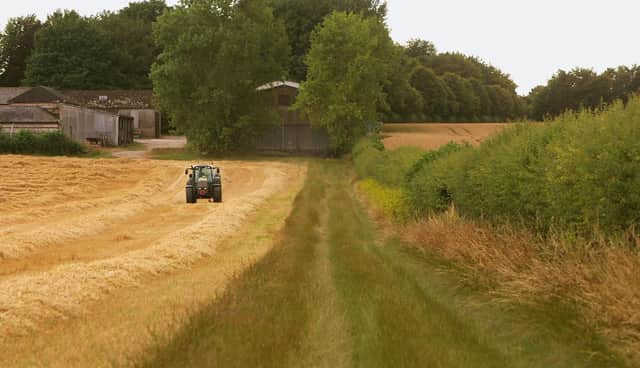After Brexit ends Common Agricultural Policy subsidies to landowners, the public interest is key to its replacement – Martyn McLaughlin


For decades, the policy has proved a vital, if imperfect contract between agriculture and society. It ensures that those who make their living from the land are able to do so without the fear of penury, and it guarantees all of us a stable supply of affordable food.
Without the basic payment provided by the CAP system, countless farming businesses across Scotland would not be viable, and without some of the supplementary payments – such as those for ‘greening’ methods – our natural environment would be a lot worse off.
Advertisement
Hide AdAdvertisement
Hide AdRural communities right to be nervous
And without CAP, some of the country’s leading charities would be staring at a financial black hole. Last year, RSPB Scotland received more than £4.6 million through the initiative, £2.8m of which came in the form of direct aid.
But as with so many other mechanisms, CAP will soon be no more thanks to Brexit. With no clear sign of what will replace it, entire industries and rural communities have every right to be nervous.
As things stand, a continuity system will remain in place until 2024, under which the Scottish government will oversee a “simplified” process. But make no mistake – what follows will rightly be subject to spirited debate.
There are already signs of divergence between the future approach in Scotland and that in England. Fergus Ewing, the Cabinet Secretary for the Rural Economy, has criticised the UK government’’s plans to stop financial support for food production by 2028 as part of its new emerging agricultural policy.
With the issue devolved, the Scottish government is likely to take an altogether different tack, and Mr Ewing has tentatively floated the idea of ensuring that pig and dairy farmers, as well as arable and hill farming, are among the beneficiaries of the new subsidy system here.
But there are other factors to be taken into account beyond a homegrown food supply chain. The tentative Westminster proposals have been praised by Tony Juniper, the chairman of Natural England, who said they could help kickstart a “revolution” which rewards those who make long-term investments which benefit the environment and help tackle the climate emergency.
With the climate crisis the defining political issue, and Glasgow hosting the COP26 UN climate change conference later this year, expect to hear a lot more about the importance of further tethering the new rural subsidy system to clearly defined environmental goals.
The Duke of Wellington’s surgeon-general
But more than that, Scotland has an opportunity to ensure that the successor to CAP does not unduly reward those with vast wealth and landholdings. Over the past few days, I have written a series of stories in The Scotsman and Scotland on Sunday detailing some of the biggest beneficiaries of CAP payments since the EU referendum.
Advertisement
Hide AdAdvertisement
Hide AdThey include serving government ministers, numerous MSPs, several peers, and a councillor who is the present-day holder of a baronetcy first conferred upon the Duke of Wellington’s surgeon-general. It also takes in foreign heads of state, oligarchs, and families whose fortunes stretch back centuries thanks to the system of aristocracy.
It also includes so-called ‘slipper farmers’ – enterprising individuals who purchase farms, and their associated subsidy entitlements, before letting them out to be managed by other people – who have routinely enjoyed seven-figure annual payments. It is a considerable reward for what seems to be to be a cynical pursuit.
Many of the biggest beneficiaries – and we are talking of those who receive hundreds of thousands, if not millions of pounds a year – receive the payments through farming businesses which are key local employers, produce plentiful food, and play their part in meeting environmental targets. Others, however, have less clearly defined societal benefits.
Benefits for billionaires
Having spent some time poring through subsidy databases, company records, and title deeds, one thing is abundantly clear: the appeal of the existing CAP system as a means of bolstering both established and new-found wealth is explicit.
In the course of researching the stories, I found glossy pamphlets produced by estate agents advertising grand sporting estates in the Highlands, which listed the amount of agricultural subsidies and grants any new owner could expect to receive.
Of course, these payments are not on the house. They require evidence of investment that fulfils the CAP criteria. Even so, it is questionable whether every recipient should benefit from basic payments, paid on a per hectare basis.
For example, Aberuchill Castle Estate near Comrie, which was bought by the billionaire Russian steel magnate, Vladimir Lisin, and which is ultimately owned by a Luxembourg firm, received tens of thousands of pounds last year for its investment in forestry. It also received more than £40,000 in basic payments.
That particular estate told me that agricultural support helps it to maintain jobs and support local employment via the likes of feeds, fuel, machinery, and tradesmen. A valid argument, albeit one best assessed alongside Mr Lisin’s personal fortune, last put at £15 billion by Bloomberg.
Advertisement
Hide AdAdvertisement
Hide AdThere are plenty of dogs in this fight, and the Scottish government has its work cut out putting in place a system that is fair and equitable. I would hope, however, that the new policy framework takes into account those calling for greater scrutiny of how such large payments of public funds to major private landowners benefit the public interest. Otherwise, what is the point?
A message from the editor:
Thank you for reading this article. We're more reliant on your support than ever as the shift in consumer habits brought about by coronavirus impacts our advertisers.
If you haven't already, please consider supporting our trusted, fact-checked journalism by taking out a digital subscription.
Comments
Want to join the conversation? Please or to comment on this article.
